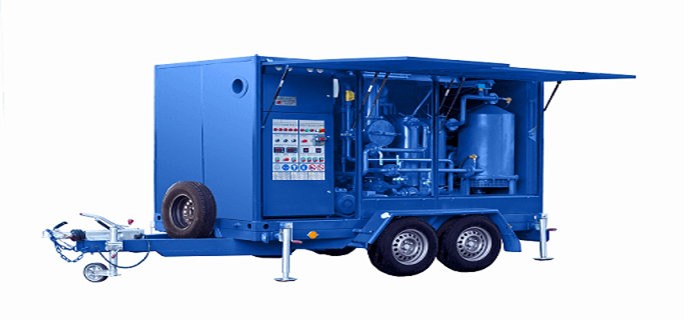Services


TRANSFORMER OIL RECLAMATION TECHNOLOGY
Reclamation restores the oil’s properties to like new condition.
The oxidation stability of the reclaimed oil is greatly improved when the process is combined with inhibitor injection.
Protects the Environment because of reduced risk of oil spills and there is no waste oil that needs to be disposed of.
New Oil Costs are greatly reduced since only a small percentage of the oil is lost in the process.
REMEDIAL ACTIONS: TRANSFORMER OIL RECLAMATION
Oil Purification is “a process that eliminates or reduces physical contamination by means of a physical cleaning processes including filtration, dehumidification, degasification, etc.” Typically, oil purification uses a combination of a mechanical filtration process and a vacuum degassing process. It can be done with the transformer off-line or on-line. The oil purification process normally results in the efficient removal of particles larger than 0.2 micron and the removal of most of the dissolved water and gases in the oil. The process is usually sufficient to correct low electrical breakdown voltage caused by a combination of particulate matter and high water content in the oil, both of which are a fairly common in aged and used oil. In order to preserve the insulating and heat transfer capabilities of the oil, it is necessary to carry out such a treatment on a scheduled maintenance basis. The Oil Purification Process however, is not a long-term solution for a wet transformer since only a small fraction of the total water content of the transformer is removed via this process. That is because up to 97% of the water and moisture is found in the insulating paper and the purification process will leave this water behind because it does not treat the paper. To obtain a significant reduction of the water content in a transformer a more powerful process, namely Oil Regeneration, must be applied.
THE SOLUTION: TRANSFORMER OIL RECLAMATION
The main principle of Oil Regeneration is to cleanse and purify the insulating oil by pumping the oil through a sorbent material such as Fuller’s Earth. During this process, the oil undergoes “molecular filtration” in the micro porous adsorbent material. The By-Products of oil aging (burnt deposits, hydro-peroxides, ketones, carboxylic acids, aldehydes, phenols, etc.) are removed and stay in the Fuller’s Earth granules. Fuller’s Earth is a naturally occurring clay that poses no environmental danger and can be disposed of as a construction waste after its absorbing properties have been exhausted. Acton regeneration units utilize the acton Process and are designed to operate with multiple sorbent filter columns. The columns can be either in oil filtration mode or adsorbent reactivation mode. As oil processing proceeds, the regeneration unit will switch between oil regeneration and sorbent reactivation. The switch takes place automatically when the absorbent has accumulated a certain amount of contaminants. This feature is managed by the Supervisory Control and Data Acquisition System (SCADA) and allows the regeneration of oil to proceed continuously without stopping to replace and dispose of spent sorbent material.
ADVANTAGES OF TRANSFORMER OIL RECLAMATION
Oil Regeneration, as compared to oil replacement or purification has several attractive and cost saving features. Although safety considerations require the de-energizing of the transformer while connecting and disconnecting the regeneration plant to and from the transformer, it is recommended to carry out regeneration on the transformer while it remains energized. This means a greatly reduced risk of disruption of the power supply to your customers. From a technical perspective, recirculation of oil within a transformer using the acton Process removes traces of old oil and contaminates from the paper insulation. In the case of oil replacement, there will be a significant amount of the old oil (up to 15%) that will remain in the windings and insulating paper that will contaminate the new oil. The transformer’s insulating paper acts just like the paper in a car’s oil filter, it filters out contaminates from the oil and retains them to its own demise. These acids and contaminates will dissolve into the new oil shortly after oil replacement reducing the effectiveness of the timely and expensive oil change. The acton Process will remove the water, moisture, acids, and other contaminates from the oil, the windings and the insulating paper without the need to replace and dispose of contaminated oil.
- Regular reclamation of oil every year doubles transformer’s service life
- Regenerationrestores the oil’s properties to like new condition.
- The oxidation stabilityof the regenerated oil is greatly improved when the process is combined with inhibitor injection.
- Protects the Environment because of reduced risk of oil spills and there is no waste oilthat needs to be disposed
- New Oil Costs are greatly reducedsince only a small percentage of the oil is lost in the process.
- No Oil transportation
- No waste Oil disposal
- Itpreserves precious resources by eliminating or greatly reducing the need to use large quantities of new oil.
- Labor costs are minimalsince the acton CMM-R units only require a one man crew.
- Saves timeover the traditional oil change process.
- The acton Process can be performed in one and five days depending on oil acid levels.
- Thousands of transformers have been successfully treated with the acton Process

